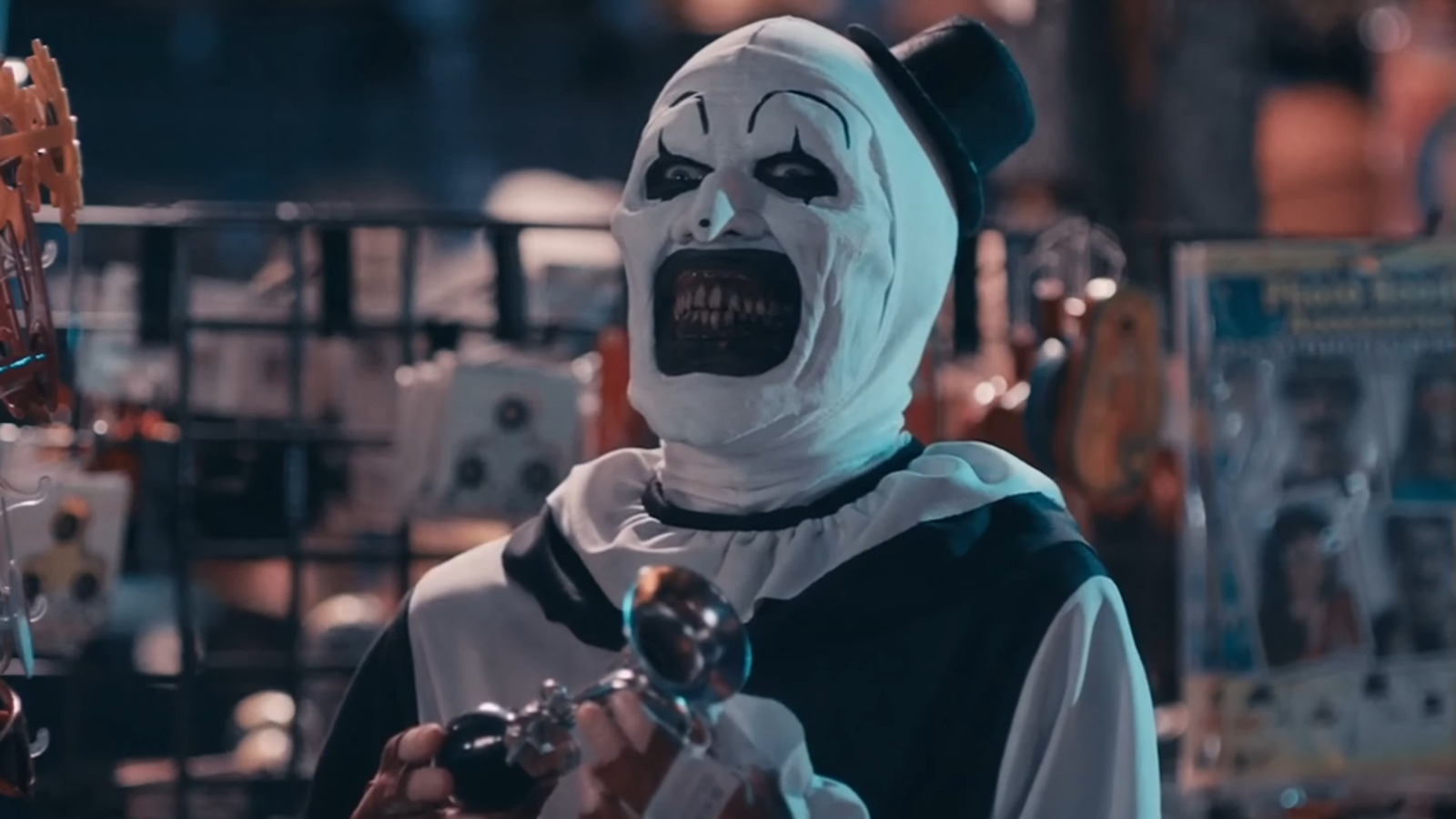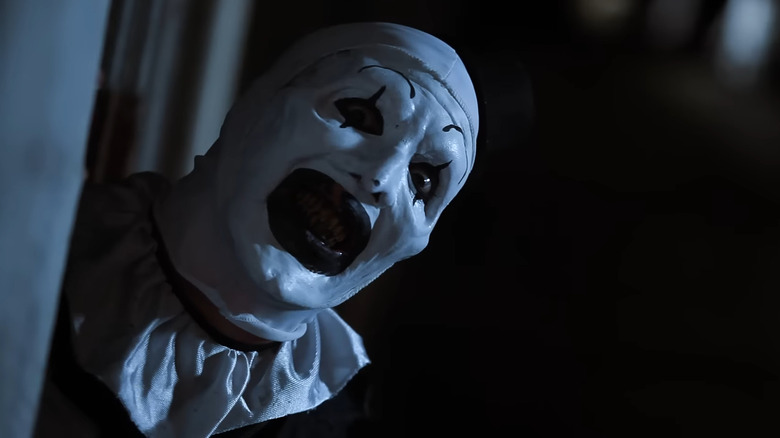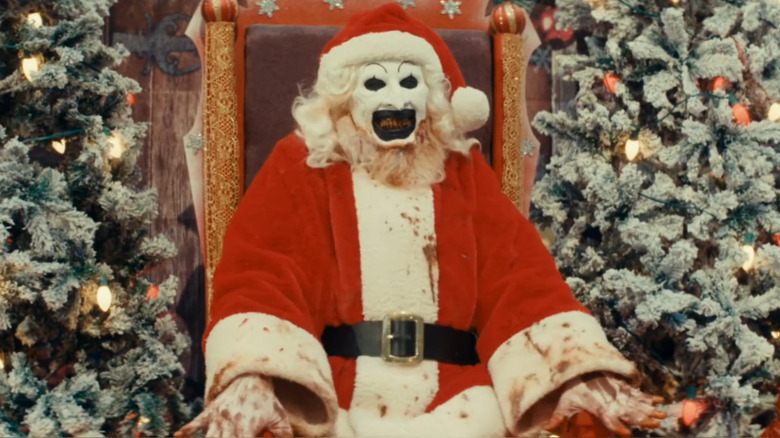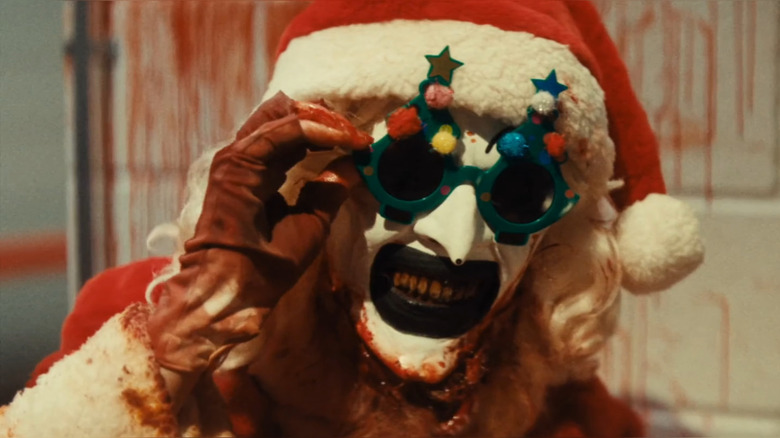
As a seasoned horror enthusiast with an eye for intriguing characters and a heart that beats faster at the sight of bloodcurdling clowns, I can confidently say that Art the Clown has left an indelible mark on my horror-loving soul. This enigmatic, black-and-white harlequin of terror, with his chilling expressions and bloodthirsty tendencies, is a testament to the power of silent storytelling in the realm of horror.
Art the Clown (David Howard Thornton) is undeniably mischievous and malicious. Brutal and thirsty for blood, he’s the unique character who wouldn’t hesitate to shove a chainsaw into another character’s backside – all while grinning and snapping a selfie with the gory mess that remains. What makes this character fascinating is his silent nature; he’s a clown whose costume and makeup are in stark contrast, much like a traditional harlequin. He communicates through facial expressions and by blowing a horn, which only serves to deepen the mystery surrounding him.
As a die-hard horror fan, I’m always intrigued by the origins of my favorite frightening figures, and Art the Clown is no exception. So, how in the twisted realm of terrifying tales did Damien Leone, the genius behind the “Terrifier” series and creator of this chilling character, bring Art to life? How did he discover David Howard Thornton and propel him to horror fame? And where did we first lay our eyes on this sinister jester? Let’s dive into the shadows and uncover Art the Clown’s secret past, future, and what drew David Howard Thornton to such a menacing role.
Art the Clown started life as a short (film) character

Art the Clown first appeared in the short film “The 9th Circle,” written and directed by Damien Leone, back in 2008. This initial appearance introduced Art as a character, setting the stage for many of his distinctive features, such as his delight in causing harm, his cool yet playful demeanor, his love for cat-and-mouse games with victims, and his propensity for extreme violence, all of which are vividly portrayed here.
During a casual brainstorming session, Leone conceived the concept for the story titled Art. As he explained to Entertainment Weekly, “The image that popped into my head was of a clown causing distress on a city bus. The woman is alone, possibly returning home from work late at night, when this clown boards and seats opposite her, staring intently and playing mind games.” He continued, “At first it might be awkward or amusing, but as time passes, the situation becomes increasingly unsettling and hostile.
The art of horror resurfaces in the 2011 short film “Terrifier” (distinct from its full-length version, released in 2016). These short films were combined to form a key part of Leone’s 2013 movie “All Hallow’s Eve.” Leone aimed to develop a character that wouldn’t resemble other horror clowns, such as Pennywise from the “It” series. He explained to Dread Central, “I felt there was a gap in clowns that hadn’t been filled in quite the way I envisioned. Art the Clown emerged from this void and the aspects of clowns I felt were lacking. At that time, the original Pennywise was the only clown around, and he wasn’t even a slasher.” This is just the beginning of Art’s terrorizing reign.
He grew to become a part of Damien Leone’s first full-length effort

Without Damien Leone’s effort to showcase Art’s earliest tales in film festivals being successful, we would not have “All Hallow’s Eve.” Leone initially shared the original “Terrifier” on YouTube for free with ads, which gained significant popularity. This success led to the release of “All Hallow’s Eve.” Despite this attention, Leone turned to Indiegogo to fund Art’s first full-length feature film. The initial campaign only managed to raise $4,360 out of a $15,000 goal. However, a donation from Phil Falcone ultimately pushed the project over its target, as shared by Leone in an interview with Dread Central. Falcone then became a producer, and Art’s first film was made.
Initially, “Terrifier” made its way onto horror-focused streaming platform Screambox, where it gained a dedicated fanbase. Later, Leone turned to Indiegogo for funding for “Terrifier 2,” surpassing the goal of $50,000 with an impressive $215,127 in donations. When the movie proved successful at the box office due to positive word of mouth, Leone received offers from major film studios. However, he declined when they insisted on toning down his vision for “Terrifier 3.” Consequently, he opted to self-finance “Terrifier 3,” which was a smart decision as it became the highest-grossing unrated film ever at the box office.
He became David Howard Thornton’s signature character (eventually)

Of course, Art’s lively antics wouldn’t be the same without David Howard Thornton’s talent. However, it’s important to note that Mike Giannell was the one who originally played Art in the short films. But when Thornton came on board for the full-length movies, he drew upon his passion for horror and his expertise in clowning to further develop Art’s character, resulting in the distinctive personality we know today.
He combined his past expertise in physical comedy and clowning with his extensive understanding and admiration for exceptional physical actors, as well as horror icons such as Robert Englund. This blend was then incorporated into what Mike had previously achieved, resulting in a chilling concoction that we might call Art – a character reminiscent of the offspring of Harpo Marx and Freddy Krueger. He expressed his joy in portraying this character to Rue Morgue.
Through pantomime, Thornton has undeniably enriched Art, pushing him towards his ultimate manifestation. Not long now until “Terrifier 4” reveals more surprises hidden within the clown’s terrifying arsenal.
Read More
- Grimguard Tactics tier list – Ranking the main classes
- Gold Rate Forecast
- 10 Most Anticipated Anime of 2025
- USD CNY PREDICTION
- Silver Rate Forecast
- Box Office: ‘Jurassic World Rebirth’ Stomping to $127M U.S. Bow, North of $250M Million Globally
- Mech Vs Aliens codes – Currently active promos (June 2025)
- Castle Duels tier list – Best Legendary and Epic cards
- Maiden Academy tier list
- All New and Upcoming Characters in Zenless Zone Zero Explained
2024-10-29 04:30